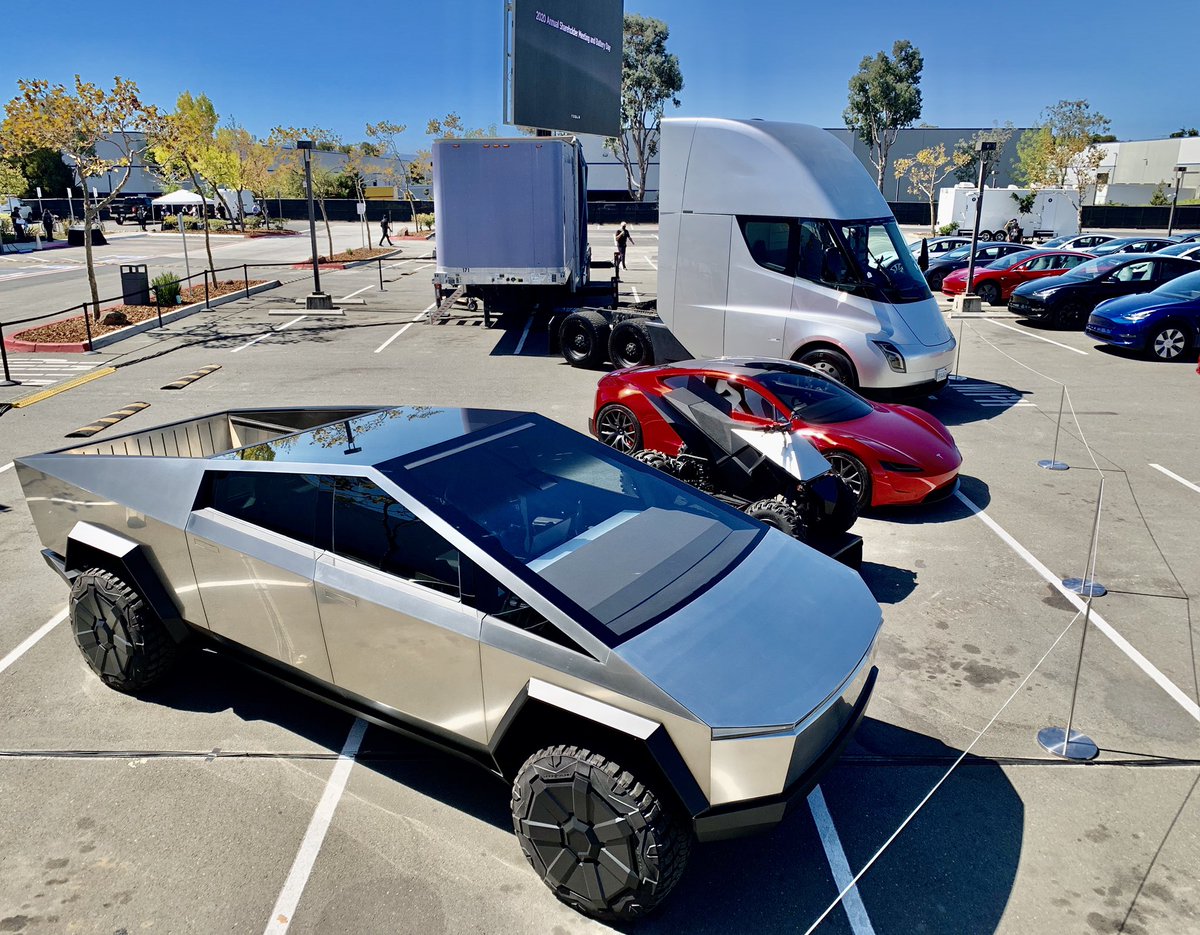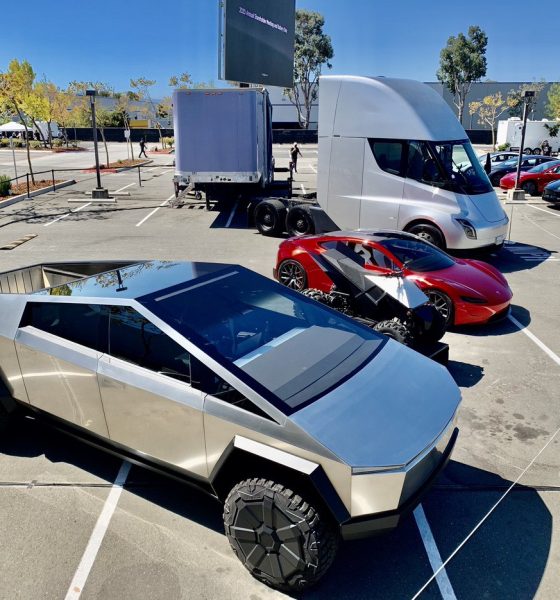

Investor's Corner
Tesla (TSLA) gets new PTs after Battery Day breakthroughs
Tesla (NASDAQ: TSLA) received a variety of new price targets from investment firms following the conclusion of the company’s Battery Day event last night. Goldman Sachs, Deutsche Bank, and Baird analysts all raised their outlook for the electric automaker’s stock following the successful Battery Day presentation, which revealed Tesla’s plans for a new battery structure, more efficient manufacturing, and its roadmap for more affordable vehicles. Morgan Stanley also commended Tesla’s event but did not increase its price target.
Tesla stock suffered a small pullback in value during and following the event, which can likely be attributed to the fact that the revealings at Battery Day will not be available immediately. CEO Elon Musk stated a day prior to the event that some of the developments will take a few years to come to fruition.
However, some firms are advising that investors take advantage of the pullback in stock value. Tesla’s announcements last night proved that the company is head and shoulders above the rest of the EV sector in terms of manufacturing, performance, and battery technology.
Goldman Sachs
Goldman Sachs analyst Mark Delaney raised his price target on TSLA stock from $295 to $400 and maintained a “Neutral” rating, according to TheFly. The increased outlook from Delaney is based on Tesla’s importance in the future widespread adoption of electric cars, as well as potential margin upside from software. Delaney wrote in a note to Goldman investors that Tesla’s goals to produce its own battery cells, along with a possible 100 GWh capacity by 2022, and 3 TWh in 2030, shows the company’s plan is set and it has a roadmap to achieve it.
Deutsche Bank
Deutsche Bank’s Emmanuel Rosner upgraded his rating on Tesla stock from “Hold” to “Buy” and raised his price target from $400 to $500. Rosner stated that although Wall Street’s reaction to the Tesla event was not positive, it is an opportunity for investors to take advantage of a discount on the share price. “With the stock price indicated down post-market traders ‘sell the news,’ we recommend longer-term investors to take advantage of weakness to buy Tesla as the best way to invest in vehicle electrification,” Rosner wrote to investors, according to CNBC.
Tesla debuts new 4680 battery cell: 500% more energy, 6X power, range increase
Baird
Ben Kallo of Baird increased his price target to $360 from $332 and reiterated his “Neutral” rating on the stock. The minimal increase in Kallo’s price target is because he believes the company’s current valuation already reflects significant disruption potential. “With the Battery Day in the rearview, we think there is a lack of upcoming catalysts and are cautious about demand given the recessionary environment,” Kallo writes to investors. He believes the company’s future holders should take advantage of pullbacks in stock price, MarketWatch reported.
Morgan Stanley
Morgan Stanley’s Adam Jonas stated that Tesla Battery Day “largely lived up to the hype, by didn’t clearly exceed it.” However, Jonas indicated that the plan to reduce cell cost and increase total investment cost was “substantial for this industry.” The analyst added that “applying Tesla’s 69% targeted savings to this figure (implying $174mm/10 GWh) to the 3 TWh target implies over $50bn of battery capacity investment needed to Tesla alone and $350bn for the industry to get to 20 TWh.
Tesla’s Battery Day Largely Lives Up to Hype | Morgan Stanley $TSLA pic.twitter.com/h4LeCMNRLW
— David Tayar (@davidtayar5) September 23, 2020
At the time of writing, TSLA stock was trading at $398.42.
Disclaimer: Joey Klender is a TSLA Shareholder.

Investor's Corner
Tesla stock closes at all-time high on heels of Robotaxi progress

Tesla stock (NASDAQ: TSLA) closed at an all-time high on Tuesday, jumping over 3 percent during the day and finishing at $489.88.
The price beats the previous record close, which was $479.86.
Shares have had a crazy year, dipping more than 40 percent from the start of the year. The stock then started to recover once again around late April, when its price started to climb back up from the low $200 level.
This week, Tesla started to climb toward its highest levels ever, as it was revealed on Sunday that the company was testing driverless Robotaxis in Austin. The spike in value pushed the company’s valuation to $1.63 trillion.
Tesla Robotaxi goes driverless as Musk confirms Safety Monitor removal testing
It is the seventh-most valuable company on the market currently, trailing Nvidia, Apple, Alphabet (Google), Microsoft, Amazon, and Meta.
Shares closed up $14.57 today, up over 3 percent.
The stock has gone through a lot this year, as previously mentioned. Shares tumbled in Q1 due to CEO Elon Musk’s involvement with the Department of Government Efficiency (DOGE), which pulled his attention away from his companies and left a major overhang on their valuations.
However, things started to rebound halfway through the year, and as the government started to phase out the $7,500 tax credit, demand spiked as consumers tried to take advantage of it.
Q3 deliveries were the highest in company history, and Tesla responded to the loss of the tax credit with the launch of the Model 3 and Model Y Standard.
Additionally, analysts have announced high expectations this week for the company on Wall Street as Robotaxi continues to be the focus. With autonomy within Tesla’s sights, things are moving in the direction of Robotaxi being a major catalyst for growth on the Street in the coming year.
Elon Musk
Tesla needs to come through on this one Robotaxi metric, analyst says
“We think the key focus from here will be how fast Tesla can scale driverless operations (including if Tesla’s approach to software/hardware allows it to scale significantly faster than competitors, as the company has argued), and on profitability.”

Tesla needs to come through on this one Robotaxi metric, Mark Delaney of Goldman Sachs says.
Tesla is in the process of rolling out its Robotaxi platform to areas outside of Austin and the California Bay Area. It has plans to launch in five additional cities, including Houston, Dallas, Miami, Las Vegas, and Phoenix.
However, the company’s expansion is not what the focus needs to be, according to Delaney. It’s the speed of deployment.
The analyst said:
“We think the key focus from here will be how fast Tesla can scale driverless operations (including if Tesla’s approach to software/hardware allows it to scale significantly faster than competitors, as the company has argued), and on profitability.”
Profitability will come as the Robotaxi fleet expands. Making that money will be dependent on when Tesla can initiate rides in more areas, giving more customers access to the program.
There are some additional things that the company needs to make happen ahead of the major Robotaxi expansion, one of those things is launching driverless rides in Austin, the first city in which it launched the program.
This week, Tesla started testing driverless Robotaxi rides in Austin, as two different Model Y units were spotted with no occupants, a huge step in the company’s plans for the ride-sharing platform.
Tesla Robotaxi goes driverless as Musk confirms Safety Monitor removal testing
CEO Elon Musk has been hoping to remove Safety Monitors from Robotaxis in Austin for several months, first mentioning the plan to have them out by the end of 2025 in September. He confirmed on Sunday that Tesla had officially removed vehicle occupants and started testing truly unsupervised rides.
Although Safety Monitors in Austin have been sitting in the passenger’s seat, they have still had the ability to override things in case of an emergency. After all, the ultimate goal was safety and avoiding any accidents or injuries.
Goldman Sachs reiterated its ‘Neutral’ rating and its $400 price target. Delaney said, “Tesla is making progress with its autonomous technology,” and recent developments make it evident that this is true.
Investor's Corner
Tesla gets bold Robotaxi prediction from Wall Street firm
Last week, Andrew Percoco took over Tesla analysis for Morgan Stanley from Adam Jonas, who covered the stock for years. Percoco seems to be less optimistic and bullish on Tesla shares, while still being fair and balanced in his analysis.

Tesla (NASDAQ: TSLA) received a bold Robotaxi prediction from Morgan Stanley, which anticipates a dramatic increase in the size of the company’s autonomous ride-hailing suite in the coming years.
Last week, Andrew Percoco took over Tesla analysis for Morgan Stanley from Adam Jonas, who covered the stock for years. Percoco seems to be less optimistic and bullish on Tesla shares, while still being fair and balanced in his analysis.
Percoco dug into the Robotaxi fleet and its expansion in the coming years in his latest note, released on Tuesday. The firm expects Tesla to increase the Robotaxi fleet size to 1,000 vehicles in 2026. However, that’s small-scale compared to what they expect from Tesla in a decade.
Tesla expands Robotaxi app access once again, this time on a global scale
By 2035, Morgan Stanley believes there will be one million Robotaxis on the road across multiple cities, a major jump and a considerable fleet size. We assume this means the fleet of vehicles Tesla will operate internally, and not including passenger-owned vehicles that could be added through software updates.
He also listed three specific catalysts that investors should pay attention to, as these will represent the company being on track to achieve its Robotaxi dreams:
- Opening Robotaxi to the public without a Safety Monitor. Timing is unclear, but it appears that Tesla is getting closer by the day.
- Improvement in safety metrics without the Safety Monitor. Tesla’s ability to improve its safety metrics as it scales miles driven without the Safety Monitor is imperative as it looks to scale in new states and cities in 2026.
- Cybercab start of production, targeted for April 2026. Tesla’s Cybercab is a purpose-built vehicle (no steering wheel or pedals, only two seats) that is expected to be produced through its state-of-the-art unboxed manufacturing process, offering further cost reductions and thus accelerating adoption over time.
Robotaxi stands to be one of Tesla’s most significant revenue contributors, especially as the company plans to continue expanding its ride-hailing service across the world in the coming years.
Its current deployment strategy is controlled and conservative to avoid any drastic and potentially program-ruining incidents.
So far, the program, which is active in Austin and the California Bay Area, has been widely successful.








